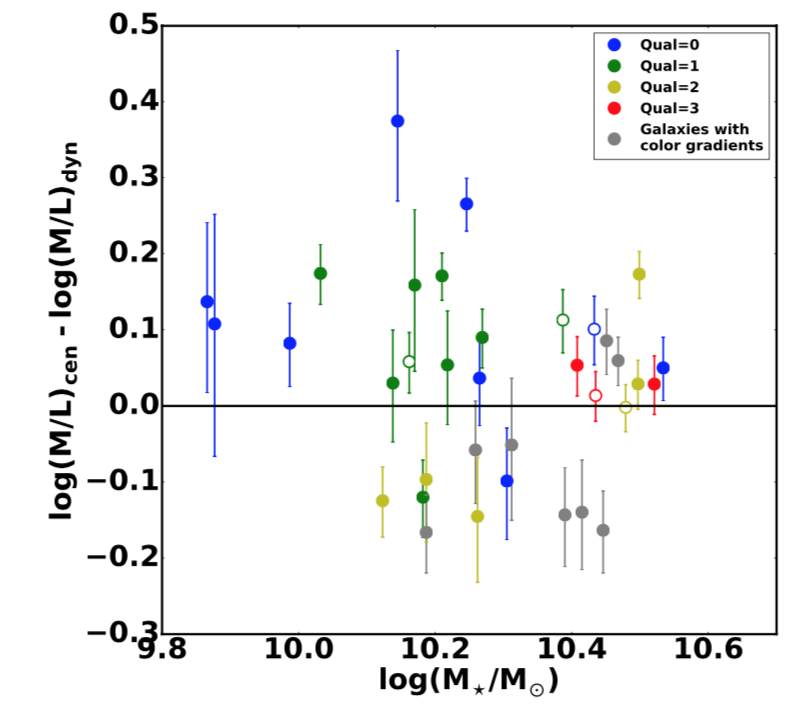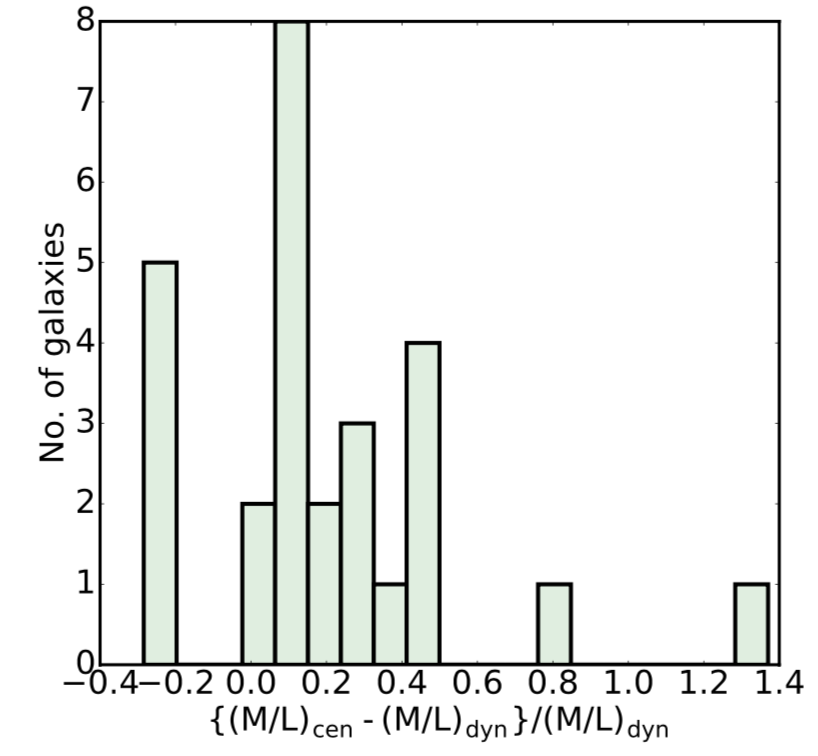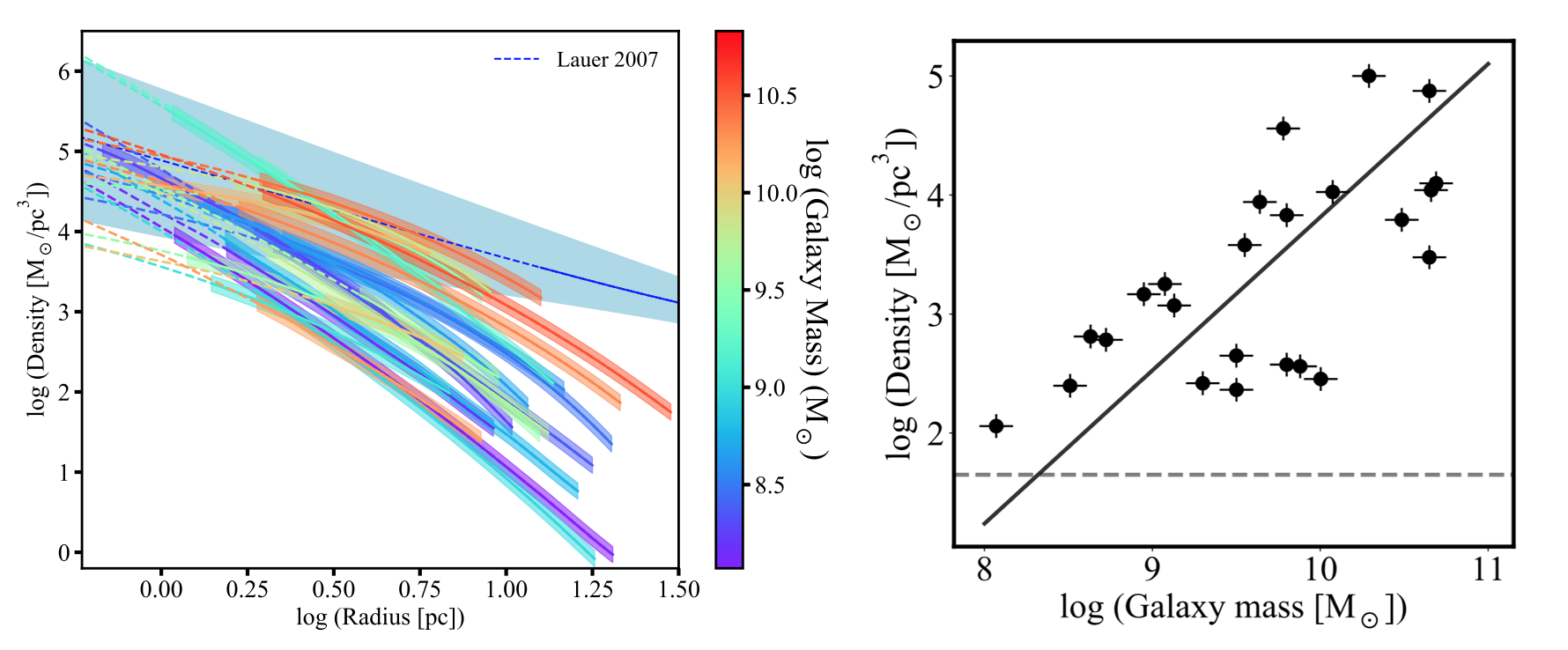Publications
1.Detection of Enhanced Central Mass-to-Light Ratios in Early-Type Galaxies: Evidence for Black holes? —- Here is the ADS link for the publication
A brief summary:
This work focuses on a sample of nearby low-mass ETGs with the purpose of finding their BH masses using ground-based low-resolution integral-field spectroscopic data. With a ∼ 1′′ resolution, we cannot usually resolve the sphere of influence for these BHs. Therefore, we implemented a new method for detecting their presence by comparing their mass-to-light ratios in the center and outer parts of the galaxies.
For this, we selected a subset of 27 galaxies from the ATLAS3D survey that also had existing high- resolution ∼ 0.05′′ Hubble Space Telescope (HST) data. We created mass models for all the galaxies using Multi-Gaussian Expansion (MGE) models. We excluded the galaxies that had large color variations in the central ∼1′′, to exclude those with stellar population variations. Using the MGE models we combined them with the central velocity dispersions from the ATLAS3D data using Jeans Anisotropic Models (JAM) to obtain a central mass-to-light (M/L) ratio. To quantify this central M/Ls, we compared them to the M/Ls that were derived by dynamically fitting the outer regions (>2′′) of the galaxies. This can be seen in Figure 1. We accounted for systematic biases, instrumental uncertainties, PSF errors, anisotropic effects etc, but we still could see a median enhancement of ∼14% in the central M/L. Assuming this enhancement is due to BHs we also derived BH masses using Jeans’ models. Recent work done in Krajnovíc et al. (2018) have confirmed BH masses in 2 galaxies from our sample using high-resolution data within 1σ of our BH masses. The primary results are:
A central M/L enhancement detected in ∼80% of the galaxies in this sample of low-mass ETGs.
Assuming this enhancement is due to BHs, we find BH masses for these galaxies. We find two galaxies with >3σ enhancement in M/L which give a high BH mass of ∼108M$_\odot$.
We also predict the possibility of low-mass ETGs acting as progenitors for Ultra-Compact Dwarf (UCD) galaxies.


Fig:1. Left Panel: The ratio of central M/Lcen and M/Ldyn in r-band (derived from dynamical models fit outside the nucleus and within ∼1R$_e$) are plotted against the mass of the galaxy. The galaxies that had a color gradient in central 1′′ are indicated in gray as their M/Lcen values are likely less reliable. The error bars include both errors from velocity dispersion measurements and mass modeling errors. Right Panel: Distribution of enhancement of central (M/L)cen with respect to (M/L)dyn. This indicates the percentage by which (M/L)cen is higher than (M/L)dyn; the median enhancement is 14%.
2.Weighing Nuclear star clusters and black holes in nearby low-mass galaxies
Here is the ADS link for the publication.
To weigh the NSCs in our nearby universe using high resolution data, we surveyed all the galaxies within 10 Mpc that hosted a visible NSC. A sample of 29 galaxies were selected to obtain kinematic data their centers using GNIRS/GEMINI and XSHOOTER/VLT; these also had multi-band, high-resolution HST data. We performed photometry on them using the IMFIT procedure typically with different S'ersic profiles and then converted them to MGE models. These models will be combined with the derived kinematic data in my following work, and NSC masses will be obtained using JAM models. Currently, we estimated their masses to understand the scaling relationships better and thus, in turn, the galaxies’ evolutionary mechanisms. For the first time, we have also derived 3D density profiles of the NSCs that also correlate with the galaxy masses. We have obtained scaling relations for the NSC densities as well, to help theorists in estimating TDE rates (such as in Stone & Metzger 2016) based on the observed central densities. This work will expand the current sample of dynamical masses of NSCs by a factor of 3, allowing us to place a firm footing on these scaling relations.
The main result of my work are:
- Mass models for NSCs 29 galaxies were created using high-resolution HST data and parameterized using S'ersic profiles.
- A correlation between NSC mass and galaxy mass were derived, and also the relations between their sizes and masses were explored.
- 3-D density profiles for the NSCs were derived for all the galaxies, which correlate with the galaxy mass, suggesting an in-situ formation mechanism for the NSCs for galaxies with higher masses. The NSC densities are resolved $\sim$1~pc and a better estimation of TDE rates can be made based on these observed densities.
 Fig:2. Left Panel: 3-D density profiles of galaxies. There is a significant correlation of NSC density with the galaxy mass (hinting in-situ formation mechanism for NSCs) and the slope of the densities get shallower with increasing galaxy mass. The dashed profiles are extrapolations of the NSC densities beyond which the model uncertainties are much larger because of lack of information. Right Panel: Densities of NSCs at a median effective radius of 5 pc of the NSC. The solid line gives the relation between galaxy mass and deprojected density. The dashed line is the typical median density of a globular cluster at a radius of 5 pc from McLaughlin & van der Marel (2005) sample.
Fig:2. Left Panel: 3-D density profiles of galaxies. There is a significant correlation of NSC density with the galaxy mass (hinting in-situ formation mechanism for NSCs) and the slope of the densities get shallower with increasing galaxy mass. The dashed profiles are extrapolations of the NSC densities beyond which the model uncertainties are much larger because of lack of information. Right Panel: Densities of NSCs at a median effective radius of 5 pc of the NSC. The solid line gives the relation between galaxy mass and deprojected density. The dashed line is the typical median density of a globular cluster at a radius of 5 pc from McLaughlin & van der Marel (2005) sample.
